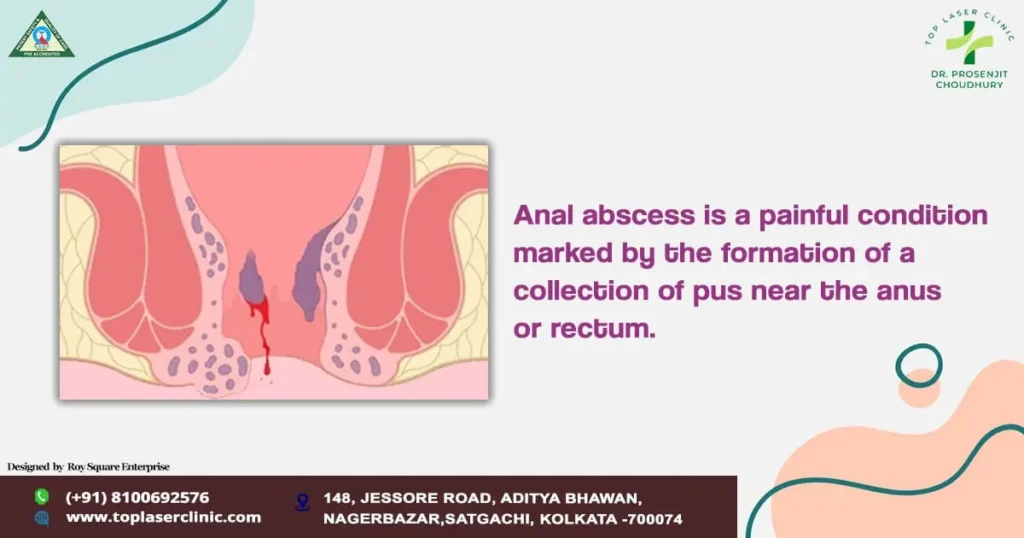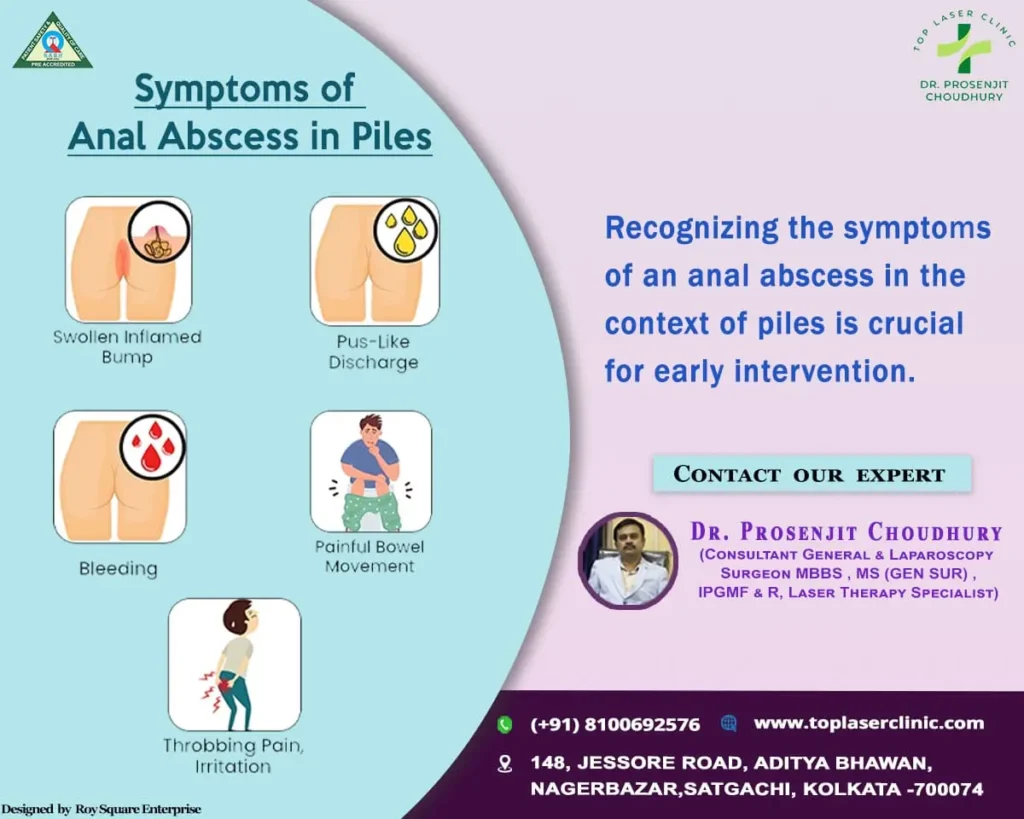Table of Contents
Anal Abscess

Dealing with health issues can be challenging, especially when it comes to conditions like anal abscesses. In this blog post, we’ll delve into the intricacies of anal abscesses, shedding light on their symptoms, causes, and available treatment options.
Understanding Anal Abscess:
An anal abscess is a painful condition marked by the formation of a collection of pus near the anus or rectum. This often results from an infection in one of the small glands lining the anal canal. Recognizing the term “anal abscess” is the first step in understanding and addressing this uncomfortable condition.
Symptoms of Anal Abscess:

Key indicators of an anal abscess include:
- Intense Pain: Anal abscesses are often associated with severe pain in the anal or rectal area. The pain may worsen during bowel movements.
- Swelling and Redness: The affected area typically becomes swollen and red. This can be externally visible, especially in the case of perianal abscesses.
- Fever: An anal abscess may cause a fever, indicating an inflammatory response to the infection.
- Discharge or Pus: Pus may accumulate within the abscess, leading to the formation of a lump near the anus. Drainage of pus may occur spontaneously or upon palpation.
- Tenderness: The area around the abscess is usually tender to touch, contributing to the overall discomfort.
- Difficulty Sitting or Moving: Due to pain and discomfort, individuals with anal abscesses may find it challenging to sit or move comfortably.
- Changes in Bowel Habits: Some individuals may experience changes in bowel habits, such as constipation or diarrhea, as a result of the abscess.
It is crucial to be aware of these symptoms to seek timely medical attention.
Causes of Anal Abscess:
Anal abscesses typically arise from bacterial infections, often originating in the anal glands. Obstructed anal glands, sexually transmitted infections, or conditions like Crohn’s disease can contribute to the development of anal abscesses. Understanding these causes is pivotal for both prevention and effective management.
Types of Anal Abscess:

There are various types of anal abscesses, with perianal abscesses being one of the most common. Recognizing the specific type is crucial for tailoring treatment approaches. Now, we will unravel the layers of different types of anal abscesses, shedding light on their unique features.
- Perianal Abscess:The most common type of anal abscess is the perianal abscess. It forms just beneath the skin surrounding the anus. Symptoms include localized pain, swelling, redness, and possibly a visible lump near the anal opening. Recognizing these signs is crucial for prompt diagnosis and treatment.
- Ischiorectal Abscess:Deeper within the layers of tissue surrounding the anus lies the ischiorectal abscess. This type of abscess is often more extensive and can cause severe pain and swelling. Identifying symptoms such as deep-seated discomfort and tenderness in the anal area is indicative of an ischiorectal abscess.
- Intersphincteric Abscess:Located between the layers of the anal sphincter muscles, the intersphincteric abscess can cause pain and discomfort during bowel movements. Recognizing symptoms such as pain exacerbated by defecation and the presence of pus discharge is essential in identifying this type of abscess.
- Supralevator Abscess:Deeper still, beyond the anal sphincter muscles, lies the supralevator abscess. This type of abscess is positioned in the upper part of the anal canal, often causing deep pelvic pain and discomfort. Understanding symptoms like pelvic pain, fever, and rectal fullness is vital in diagnosing a supralevator abscess.
- Submucosal Abscess:In some cases, an infection in the anal glands may lead to the formation of a submucosal abscess. This type is situated beneath the mucous membrane lining the anal canal. Symptoms may include rectal bleeding, pain during bowel movements, and a feeling of incomplete evacuation.
Treatment Approaches for Different Types:
Understanding the specific type of anal abscess is crucial for tailoring an effective treatment plan. While commonalities such as incision and drainage procedures, antibiotics, and sitz baths exist, the location and extent of the abscess influence the approach taken by healthcare professionals.
Treatment of Anal Abscess:
- Incision and Drainage: The primary treatment for an anal abscess involves a minor surgical procedure known as incision and drainage. A healthcare professional will make a small incision to allow the pus to drain out, relieving pain and pressure.
- Antibiotics: In cases where the infection has spread or if there’s a risk of systemic infection, antibiotics may be prescribed to help control the bacterial infection.
- Sitz Baths: Soaking the affected area in warm water, known as sitz baths, can help reduce pain and promote healing. This is often recommended as part of home care.
- Pain Management: Over-the-counter pain medications or prescription pain relievers may be recommended to manage the discomfort associated with anal abscesses.
- Maintaining Good Hygiene: Keeping the anal area clean is crucial for preventing further infection. Gentle cleansing with mild soap and water after bowel movements is recommended.
- Fiber-Rich Diet: Consuming a diet high in fiber can help soften stools and reduce strain during bowel movements, promoting healing and preventing recurrence.
- Follow-Up Care: Regular follow-up appointments with a healthcare provider are essential to monitor the healing process and address any concerns or complications.
- Preventive Measures: To prevent future anal abscesses, individuals should practice good anal hygiene, avoid anal trauma, and address underlying conditions such as inflammatory bowel disease.
It’s important to note that self-diagnosis and self-treatment are not advisable for anal abscesses. If you suspect you have an anal abscess or are experiencing related symptoms, seek prompt medical attention for proper diagnosis and tailored treatment.
Prevention and Lifestyle Considerations:
In addition to comprehending the various types of anal abscesses, individuals can take proactive measures to reduce their risk. Maintaining good anal hygiene, avoiding anal trauma, and addressing underlying conditions such as inflammatory bowel disease contribute to prevention.
Anal abscesses are not uniform in their presentation, and recognizing the different types is key to effective management. By understanding the symptoms associated with perianal, ischiorectal, intersphincteric, supralevator, and submucosal abscesses, individuals can work collaboratively with healthcare professionals to achieve timely diagnosis and appropriate treatment.
Recovery and Recurrence:
Recovery from an anal abscess involves proper wound care, pain management, and, in some cases, follow-up procedures. Understanding the potential for recurrence is essential. Lifestyle modifications, maintaining good hygiene, and addressing underlying health conditions can contribute to preventing future occurrences.
Seeking Professional Help:
The importance of seeking medical attention cannot be overstated when dealing with an anal abscess. If you suspect you may have an anal abscess or are experiencing related symptoms,”urgent care,” “colorectal specialist,” and “diagnosis” underscore the need for timely intervention. Delaying treatment can lead to complications, emphasizing the urgency of consulting with a healthcare professional.
Understanding Anal Abscess in the Context of Hemorrhoids
Dealing with the discomfort of hemorrhoids is challenging enough, but when it leads to complications like anal abscesses, the situation can become even more daunting. In this blog post, we’ll explore the relationship between anal abscesses and piles (hemorrhoids), shedding light on the causes, symptoms, and potential treatment options.
Hemorrhoids and Anal Abscess:
Hemorrhoids, commonly known as piles, are swollen blood vessels in the rectum and anus that can cause pain, itching, and bleeding during bowel movements. While hemorrhoids themselves are a prevalent condition, they can sometimes lead to complications, one of which is the development of anal abscesses.
Causes of Anal Abscess in Piles:
The connection between hemorrhoids and anal abscesses lies in the potential for infection. When hemorrhoids become inflamed or irritated, the surrounding tissue can be prone to infection. If bacteria enter the irritated hemorrhoidal tissue or nearby anal glands, it may result in the formation of an anal abscess.
Symptoms of Anal Abscess in Piles:
Recognizing the symptoms of an anal abscess in the context of piles is crucial for early intervention. Symptoms may include intensified pain during bowel movements, swelling around the anus, fever, and the presence of pus or discharge. It’s essential to distinguish these signs from typical hemorrhoidal symptoms to ensure accurate diagnosis and treatment.
Treatment Options:
Addressing anal abscesses in the presence of hemorrhoids may involve a combination of approaches. Options such as “incision and drainage,” “antibiotics,” and “hemorrhoid management” are integral to understanding the multifaceted treatment process. Managing hemorrhoids concurrently is crucial for preventing further complications.
Preventive Measures:
Preventing the development of anal abscesses in the context of piles involves practicing good anal hygiene, maintaining a high-fiber diet, and avoiding prolonged sitting. Individuals with hemorrhoids should be proactive in managing their symptoms and promptly address any changes or worsening discomfort.
Consulting with a Healthcare Professional:
When dealing with the complexities of anal abscesses in the presence of piles, seeking professional medical advice is paramount. Keywords such as “colorectal specialist,” “diagnosis,” and “timely intervention” emphasize the importance of consulting with a healthcare professional for accurate diagnosis and personalized treatment plans.
Understanding the connection between anal abscesses and piles is crucial for individuals experiencing discomfort in the anal region. By recognizing the causes, symptoms, and potential treatment options, individuals can actively participate in their health management. If you suspect you may have an anal abscess or are experiencing complications related to hemorrhoids, do not hesitate to consult with a healthcare professional for proper diagnosis and guidance. Your well-being is of utmost importance, and timely intervention can make a significant difference in your comfort and recovery.
Navigating the complexities of an anal abscess requires a comprehensive understanding of its symptoms, causes, and treatment options. By familiarizing yourself with these keywords, you empower yourself to recognize the signs, seek timely medical attention, and actively participate in your recovery. If you suspect you may have an anal abscess or are experiencing related symptoms, do not hesitate to consult with a healthcare professional for accurate diagnosis and tailored guidance. Your health and well-being are of utmost importance.